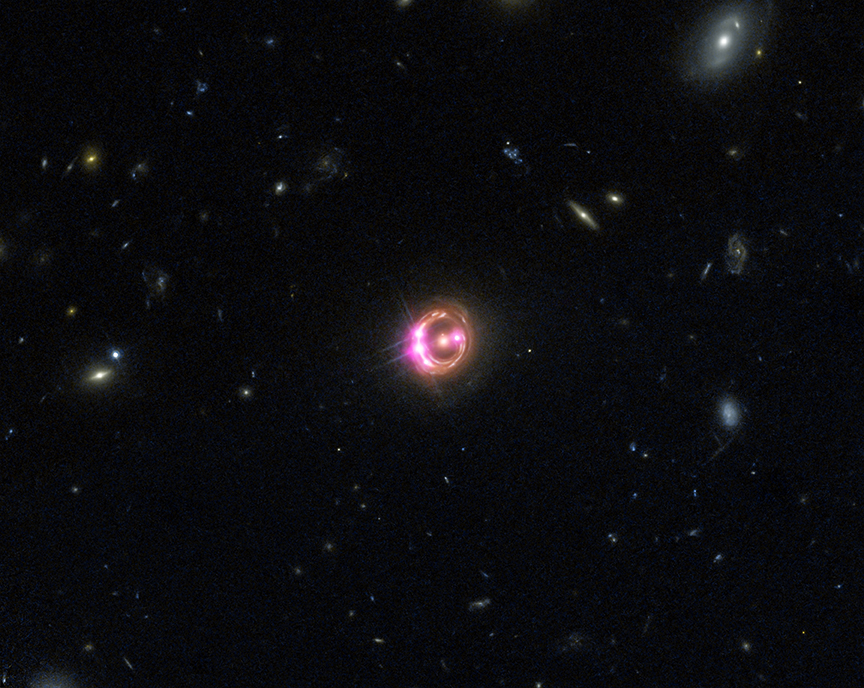
Multiple images of a distant quasar known as RX J1131-1231 are visible in this combined view from Chandra (pink) and Hubble (red, green, and blue): NASA
By Glynn Wilson –
Astronomers have accomplished the first direct measurement of the spin of a distant black hole, an important advance for understanding how black holes grow over time, scientists say. The research suggests that this black hole grew by gradually merging material rather than pulling in material in from different directions.
NASA’s Chandra X-ray Observatory and the European Space Agency’s XMM-Newton were used to show a supermassive black hole six billion light years from Earth spinning extremely rapidly. Black holes are defined by two characteristics: mass and spin. While astronomers have long been able to measure black hole masses effectively, determining their spins has been much more difficult, according to the National Aeronautics and Space Administration.
In the past decade, astronomers have devised ways of estimating spins for black holes at distances greater than several billion light-years away, allowing scientists to see the region around black holes as they were billions of years ago.
“We want to be able to cut out the middle man, so to speak, of determining the spins of black holes across the universe,” said Rubens Reis of the University of Michigan in Ann Arbor, who led a paper describing this result that was published Wednesday in the journal Nature.
Reis and his colleagues determined the spin of the supermassive black hole that is pulling in surrounding gas, producing an extremely luminous quasar known as RX J1131-1231. Because of fortuitous alignment, the distortion of space-time by the gravitational field of a giant elliptical galaxy along the line of sight to the quasar acts as a gravitational lens that magnifies the light from the quasar.
Gravitational lensing, first predicted by Einstein, offers a rare opportunity to study the innermost region in distant quasars by acting as a natural telescope and magnifying the light from these sources.
“Because of this gravitational lens, we were able to get very detailed information on the X-ray spectrum – that is, the amount of X-rays seen at different energies – from RX J1131,” co-author Mark Reynolds of Michigan said. “This in turn allowed us to get a very accurate value for how fast the black hole is spinning.”
The X-rays are produced when a swirling accretion disk of gas and dust that surrounds the black hole creates a multimillion-degree cloud, or corona near the black hole. X-rays from this corona reflect off the inner edge of the accretion disk. The strong gravitational forces near the black hole alter the reflected X-ray spectrum. The larger the change in the spectrum, the closer the inner edge of the disk must be to the black hole.
“We estimate that the X-rays are coming from a region in the disk located only about three times the radius of the event horizon, the point of no return for infalling matter,” said Jon M. Miller of Michigan, another author on the paper. “The black hole must be spinning extremely rapidly to allow a disk to survive at such a small radius.”
A spinning black hole drags space around with it and allows matter to orbit closer to the black hole than is possible for a non-spinning black hole, for example. If black holes grow mainly from collisions and mergers between galaxies, they should accumulate material in a stable disk, and the steady supply of new material from the disk should lead to rapidly spinning black holes.
If, on the other hand, black holes grow through many small accretion episodes, they will accumulate material from random directions, making the black hole spin more slowly like a merry go round pushed both backwards and forwards. The discovery that the black hole in RX J1131 is spinning at more than half the speed of light suggests this black hole, observed at a distance of six billion light years away, corresponding to an age about 7.7 billion years after the Big Bang, has grown via mergers rather than pulling material in from different directions.
“The ability to measure black hole spin over a large range of cosmic time should make it possible to directly study whether the black hole evolves at about the same rate as its host galaxy,” NASA said in the press release announcing the finding. “The measurement of the spin of the RX J1131-1231 black hole is a major step along that path and demonstrates a technique for assembling a sample of distant supermassive black holes with current X-ray observatories.”
Prior to the announcement of this work, the most distant black holes with direct spin estimates were located 2.5 billion and 4.7 billion light-years away.
NASA’s Marshall Space Flight Center in Huntsville, Ala., manages the Chandra program for the Science Mission Directorate in Washington. The Smithsonian Astrophysical Observatory in Cambridge, Mass., controls Chandra’s science and flight operations.
For an additional interactive image, podcast and video on the finding, click on one of these
Chandra Websites.













